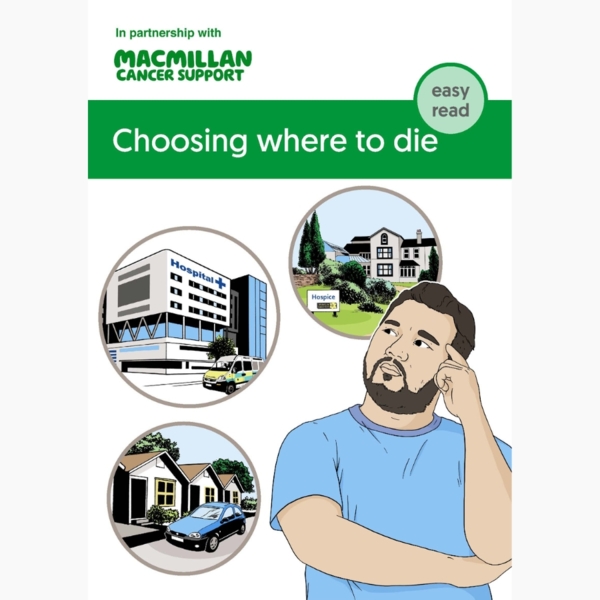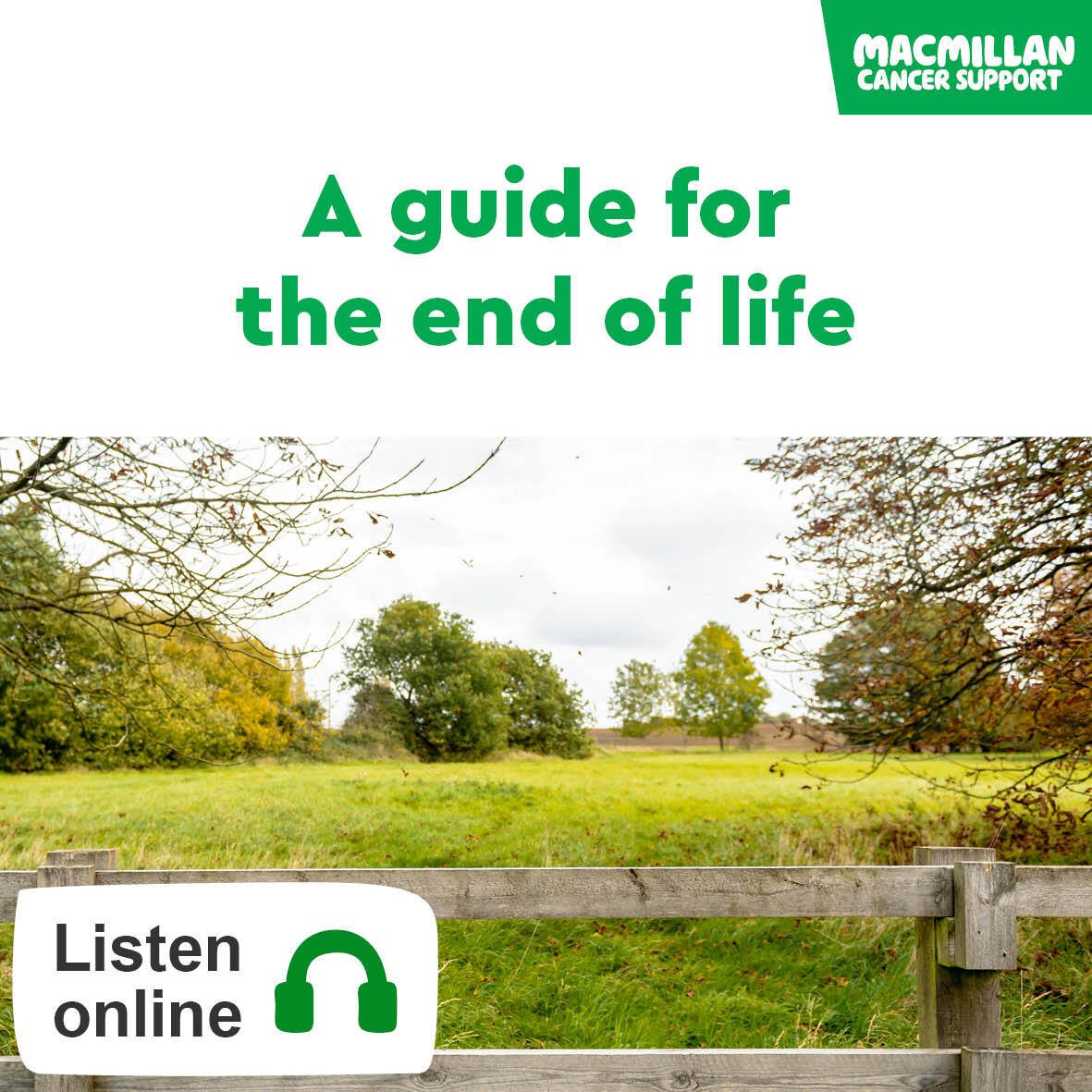Choosing where to die
The care you receive at the end of your life may depend on your preferences, as well as the help and support available.
Choosing where to die
It can be hard to think about where you would prefer to die. The choice can depend on:
- what you would like
- what help you have from family and friends
- the services available where you live
- your medical condition.
Some people prefer to die at home, surrounded by the people and things that are important to them. Others may prefer to be somewhere like a hospice. Wherever you are cared for, it is important that your symptoms are well managed and you get the care you need. This can happen in different places.
Booklets and resources
At home
Staying at home may help you feel more in control as it allows you to be in a familiar place. You may also have close family members, friends or a partner to look after you. You might find it easier to say goodbye to people you love when you are in your own home.
You may need extra help if you are being looked after at home. But caring can be hard work for the people looking after you, both physically and emotionally. There are many health and social care professionals who can help with your care.
Your district nurse, specialist nurse or GP can tell you how to get help from health and social care professionals and voluntary organisations. They can also tell you about any specific help and support available in your area.
Related pages
Hospice
Hospices specialise in caring for people who have a terminal illness and may be close to the end of their life.
They have doctors and specialist palliative care nurses who are experts in controlling symptoms such as pain. They also provide emotional support. Many hospices have nurses and healthcare assistants who can visit and help care for people at home. These are sometimes called Hospice at Home services.
You can go into a hospice for different reasons. For example, you may stay there for a short time to get your symptoms under control. Some hospices offer respite care. This means you can go in for a short time to give your carer a break. Your palliative care team can tell you what is available at your local hospice.
You may decide that you would prefer to die in a hospice. You will need to discuss your wishes with your GP and the hospice team involved with your care. You may also want to talk about your wishes with close family members, friends or a partner.
Hospices are very different to hospitals. They are smaller and quieter, and aim to provide care to suit each person’s situation.
Visiting is usually less restricted than in a hospital. As well as practical nursing care, they may offer other services for patients and their families. These may include counselling, spiritual care, and psychological support.
Accommodation and care in a hospice are free of charge. There is a limited number of beds in each hospice, so there may be a waiting list.
You can find out more about your local hospice from your GP, district nurse or palliative care nurse. Hospice UK also has useful information about hospices and where they are across the UK. You can search for hospices in your area. Marie Curie also has more information on hospice care.
If you are not sure about hospice care, you can ask to visit a hospice. The staff can show you around and talk through any questions or concerns you have.
Residential homes or care homes with nursing
If you might need care for several months, you may prefer to be looked after in a residential care home, or care home with nursing (nursing home). A nursing home has qualified nurses on their staff to provide nursing care. They usually offer short-stay or long-stay care.
You may still be able to go to a hospice for day care if that is available. Or a specialist nurse from a hospice may be able to visit you in the care home.
Your GP, district nurse or social worker can explain the different types of care homes to you. They can arrange for you to stay in a care home, either with or without nursing care.
Many care homes are privately owned. However, some are run by a charity or the local council. You usually need to contribute towards the costs of staying in a care home. This depends on your financial situation.
NHS UK has information about care homes and funding for care. You may be able to get a list of local care homes from your local county council. Carehome UK also has information about care homes and funding.
Hospital
If you have been in and out of hospital over the last few months, you may want to go back there when you need full-time nursing care. This might be easier to arrange if you have been in a small local hospital rather than a district general or teaching hospital.
Although many people die in hospital, it is not always a peaceful place to be. Often your care has to fit into the ward routine. This means you may not always be looked after in the way that you would like.
If you are in hospital, a palliative care team may be able to see you and be involved in your care. They can help manage your symptoms and offer you and your family emotional support.
About our information
-
References
Below is a sample of the sources used in our advanced cancer information. If you would like more information about the sources we use, please contact us at cancerinformationteam@macmillan.org.uk
Health Improvement Scotland/ NHS Scotland. Scottish Palliative Care Guidelines. Available from www.palliativecareguidelines.scot.nhs.uk/ [accessed Nov 2021].
NICE. Care of dying adults in the last days of life. NICE guideline NG31 [Internet]. 2015. Available from www.nice.org.uk/guidance/NG31 [accessed Nov 2021].
NICE. End of life care for adults: service delivery. NICE guideline NG142 [Internet]. 2019. Available from www.nice.org.uk/guidance/ng142 [accessed Nov 2021].
NICE. Improving supportive and palliative care for adults with cancer. Cancer service guideline CSG4 [Internet]. 2004. Available from www.nice.org.uk/guidance/csg4 [accessed Nov 2021].
-
Reviewers
This information has been written, revised and edited by Macmillan Cancer Support’s Cancer Information Development team. It has been reviewed by expert medical and health professionals and people living with cancer. It has been approved by Senior Medical Editor, Dr Viv Lucas, Consultant in Palliative Medicine.
Our cancer information has been awarded the PIF TICK. Created by the Patient Information Forum, this quality mark shows we meet PIF’s 10 criteria for trustworthy health information.
The language we use
We want everyone affected by cancer to feel our information is written for them.
We want our information to be as clear as possible. To do this, we try to:
- use plain English
- explain medical words
- use short sentences
- use illustrations to explain text
- structure the information clearly
- make sure important points are clear.
We use gender-inclusive language and talk to our readers as ‘you’ so that everyone feels included. Where clinically necessary we use the terms ‘men’ and ‘women’ or ‘male’ and ‘female’. For example, we do so when talking about parts of the body or mentioning statistics or research about who is affected.
You can read more about how we produce our information here.
Date reviewed
This content is currently being reviewed. New information will be coming soon.

Our cancer information meets the PIF TICK quality mark.
This means it is easy to use, up-to-date and based on the latest evidence. Learn more about how we produce our information.





